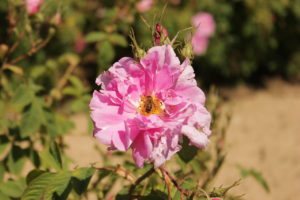Rosa × damascena, more commonly known as the Damask rose, or sometimes as the Rose of Castile, is a rose hybrid, derived from Rosa gallica and Rosa moschata. Further DNA analysis has shown that a third species, Rosa fedtschenkoana, is associated with the Damask rose
Contents
Uses
Culinary and pharmacological uses.
Benefits
Culinary
Damascus roses are used in cooking as a flavouring ingredient or spice. It appears as one of the ingredients in the Moroccan spice mixture known as ras el hanout. Rose water and powdered roses are used in Persian, Indian, and Middle Eastern cooking. Rose water is often sprinkled on meat dishes, while rose powder is added to sauces. Chicken with rose is a popular dish in Persian cuisine. Whole flowers, or petals, are also used in the herbal tea “zuhurat”. The most popular use, however, is in the flavoring of desserts such as ice cream, jam, Turkish delights, rice pudding, yogurt etc.
Western cookery today does not make much use of roses or rose water. However, it was a popular ingredient in ancient times and continued to be popular well into the Renaissance. It was most commonly used in desserts, and still is found as a flavour in traditional desserts such as Marzipan or Turrón. It has seen some revival in television cooking in the twenty-first century.
Pharmacological properties
Pharmacological effects of extracts from flowers from Rosa damascene have been the subject a number of scientific studies. A review article published in 2011 summarised these studies.
Cautions
No side effects are known.
Interactions
None are recorded.
Other names
References
Source: Wikipedia, https://en.wikipedia.org/wiki/Rosa_%C3%97_damascena

